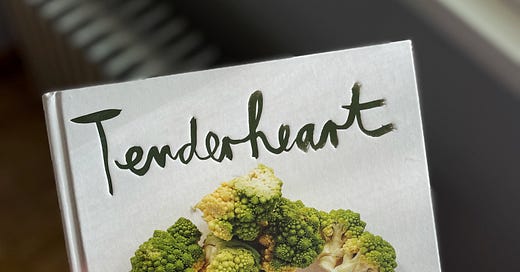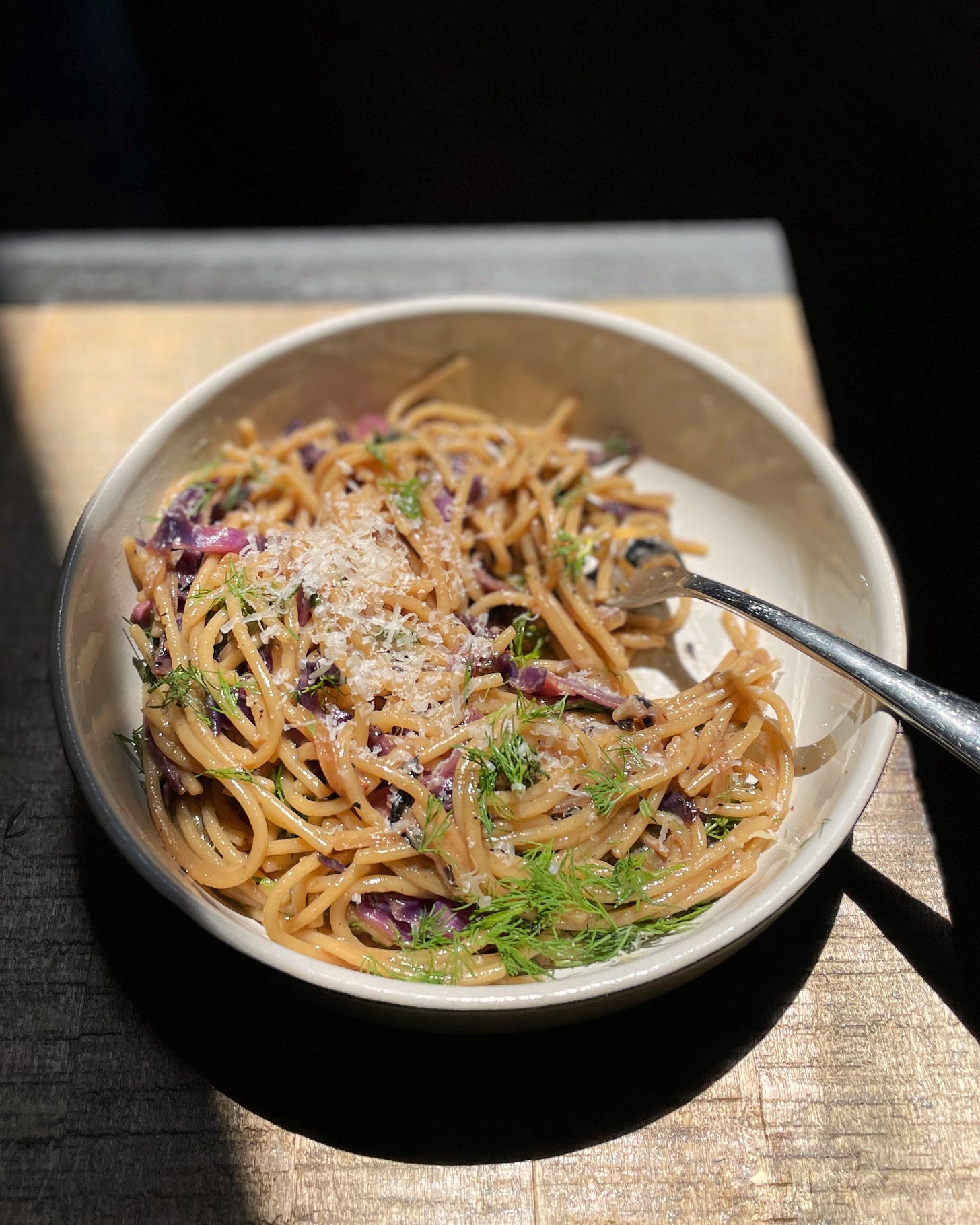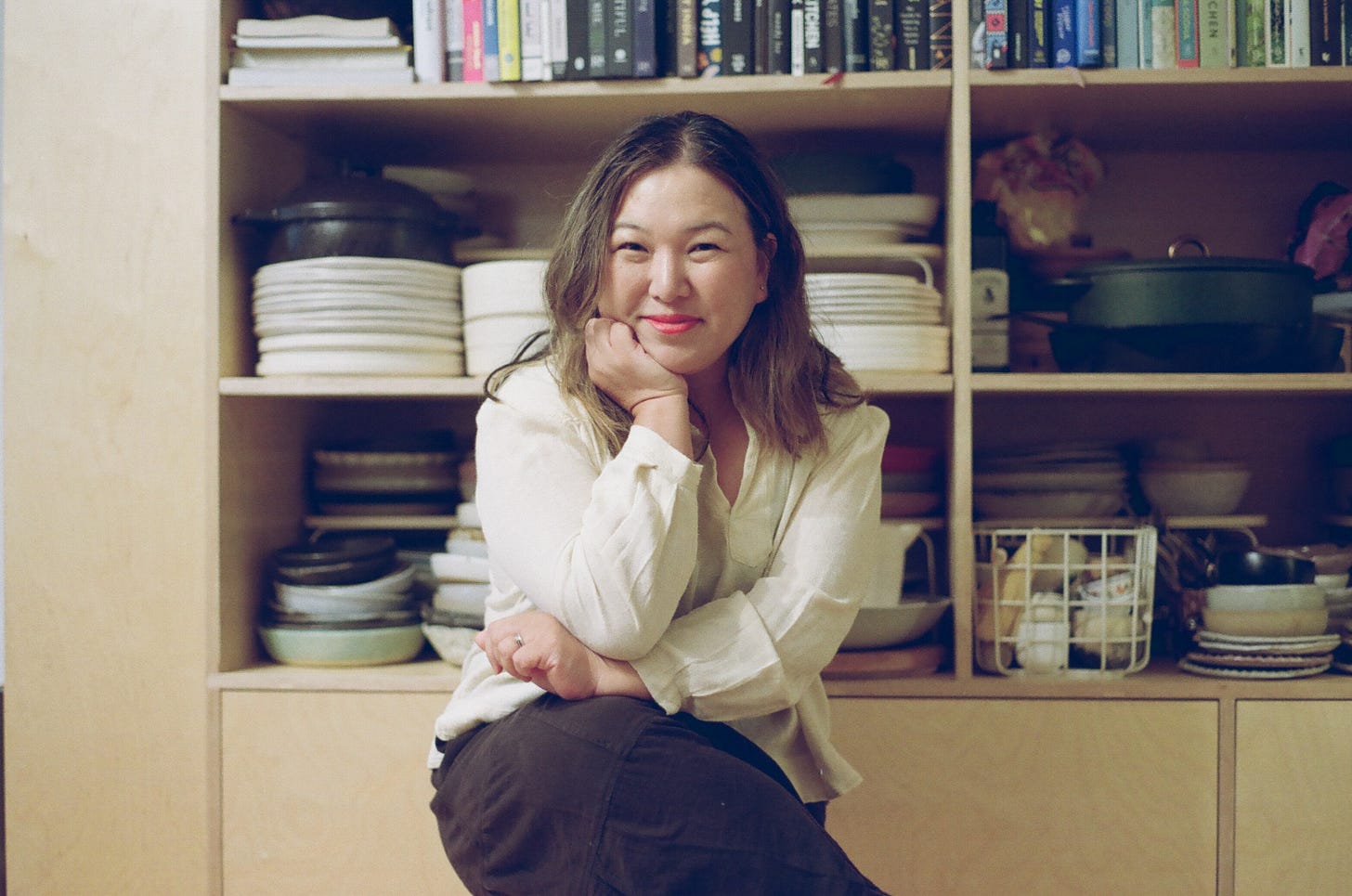Hetty, the Vegetable Queen
A chat with Hetty Lui McKinnon about her canonical new cookbook Tenderheart
One of the great privileges of the work I do is crossing paths and, if I’m very lucky, becoming friends with people like Hetty Lui McKinnon. I met her a few years ago at a food event, and we quickly bonded over a number of shared interests — vegetables and cookbooks, of course, but also indie publishing, mild obsessions with George Michael, and, since I’d recently met (and would soon marry) my Australian husband Vincent, a Down Under connection as well.
If you aren’t familiar with her story already, let me just say that her trajectory into food is organic as it could possibly get. Living in the Sydney neighborhood of Surry Hills on Arthur Street, she started a salad delivery business called Arther Street Kitchen. She’d cook up bright, globally-inspired, fortifying, vegetarian salads which she delivered — by bicycle — to the neighbors who placed orders. Word spread rapidly, and as her business gained in popularity and she fielded nonstop requests for recipes, it led to the self-published cookbook Community, which gathered those salad recipes and celebrated the community she created. Community quickly became an Australian classic.
She and her family moved to Brooklyn, NY, in 2015, where her popularity and influence have continued to spread, thanks in part to more award-winning cookbooks and beloved recipes in the New York Times and elsewhere. And next week, her fifth, most arguably ambitious book yet, Tenderheart, will hit shelves.
Like many of us, I love Hetty’s recipes for how brilliantly accessible, thoroughly researched, touchingly personal, and vibrant and fun they always are — her Buttery Miso Vegemite Noodles from To Asia, With Love is a big favorite of mine — and Tenderheart delivers mightily on recipe expectations with a whopping 22 chapters and 528 pages. I got my Australian edition at the beginning of the year, and from the homemade matcha-kale noodles tossed in a scalliony, gingery tangle of greens; to a brilliant spin on cacio e pepe with rice noodles, sugar snap peas, and a complex pepper blend; and the cheesy, spicy, stick-to-the-ribs kale and cheddar rice cake bake that’s impossible not to love, everything is a keeper.
But it’s also a singular tribute to her late father, who worked at the Sydney produce markets and may have inadvertently nudged her down the path she’s forging today. Her touching reflections, and the artful way she has infused the book with his presence, makes this hefty collection of useful recipes much more than just a cookbook: it’s a uniquely personal and moving work of memoir, too.
Read on for my Q&A with Hetty — but be sure to check out Tenderheart, which deserves a spot on your bookshelf! And for paid subscribers, keep an eye on your inboxes tomorrow for a special, Hetty-inspired recipe that’s a summer spin on a comforting winter dish.
Reminder — the revised and updated edition of my first cookbook Veggie Burgers Every Which Way publishes in just under two weeks! Be sure to preorder if you’d like to be the first to receive your copy.
Q&A with Hetty Lui McKinnon
Tenderheart is your fifth vegetable-centric cookbook and such a moving tribute to your late father. How did it happen that he became so central to this project?
To Asia, With Love was published in 2021 in the USA during Covid, at a time when Asian hate crimes were spiraling, so it felt like a heavy period for me. A lot of the media was centered around my identity as a “third culture” kid, and my Chinese-Australian heritage — which were central topics of my book — but talking about these topics during interviews felt intense. I really felt the weight of the world on my shoulders, to represent an entire community, when in reality, my work only really represents my own personal experience. So I really wanted to work on a “lighter” book — I know, the irony!
I was longing to write my vegetable manifesto, a story that emphatically put my stamp on how I — a Chinese woman raised in the Western world — like to cook and eat vegetables. I’m sure you’ve noticed, but the vegetable world can feel quite one-note. Let’s throw a beautiful watermelon radish or tomato on a plate and let’s rhapsodize over that. I wanted to show a different side to vegetables. One that has been learned from growing up in an immigrant family, from the perspective of an Asian woman. So those were my intentions for Tenderheart.
Writing Tenderheart was the first time I had ever really allowed myself to see my father’s impact on my life.
But when I started writing the book, the story that unfolded was not what I expected. The process of writing my “vegetable-origin story” about where and when my love of vegetables began, inevitably circled back to my father, who worked at the produce markets in Sydney and brought home crates and boxes of vegetables and fruits every day. That was my childhood, living in a Sydney suburbia surrounded by boxes of produce. That left its mark on me. My father left his mark on me and writing Tenderheart was the first time I had ever really allowed myself to see my father’s impact on my life.
Much of the Tenderheart story is about grief and loss but through the recipes, I am able to find joy and a bond with my father that I didn’t see before. I lost him when I was 15, so now, many decades later, writing this book has been very healing for me — some parts of it were painful to write, but it has also helped me find joy. I think many readers will remark on how joyous this book is. Every recipe feels like a celebration of life and this feels very fitting to honor the life of my father.
Tenderheart is organized by 21(!) different vegetables — are there any in here that you’re excited to win over readers with? Do you ever have a “vegetable skeptic” in mind when you work?
22 vegetables actually! The process of choosing the vegetables was seamless. I didn’t even really think about it. I literally sat down and wrote a list of the vegetables I love to cook most, and these are the ones that I wrote down on a piece of paper! I wanted to feature veg that are economical and accessible. I wanted to steer clear of hyper seasonal vegetables like fiddlehead figs, ramps, and globe artichokes because many people in the world don’t know what these vegetables are!
But in choosing a list of vegetables that feels true to me, there are inevitably a few vegetable “curveballs” that may not be familiar to everybody. Taro, for example, is a vegetable I am quite obsessed with. It is also my mother’s fave so I have so many fond memories of her talking about taro and then cooking us some for lunch. I hope that my Taro chapter satiates the cravings of fellow Taro lovers out there while also introducing the vegetable to those who haven’t tried it yet. Then there is seaweed, which is a sea vegetable that I think is grossly underused. Yet it is so foundational to Asian cooking, adding heaps of delicate umami. I also think it’s a fantastic pantry staple because the dehydrated variety keeps for a long time. I do hope that my seaweed chapter flips the switch and encourages home cooks to use it more in their everyday cooking.
The other surprising vegetable chapter might be Turnips and Daikon — these are unrelated vegetables but I talk about why I cheated by grouping them together in the book haha. I have been cooking with turnips for a long time, and used them quite extensively during my Arthur Street Kitchen salad days. People love them, they are full of sweet flavor with a juicy texture, and they are cheap, yet people don’t really know what to do with them. I hope to give many people more confidence to cook with vegetables like this!
I don’t really think about the vegetable skeptics, to be honest! I think my food is actually made for ALL the skeptics because my food is about showing how vegetables can be comforting and satisfying, both texturally and flavor-wise. Many people eat my food without even realizing they are eating a vegetarian meal. I love that. In my career, I have converted a lot of vegetable skeptics such as Brussels sprout haters or mushroom dissenters. That always feels like a big win for me!
One thing I always admire in your recipes is how truly weeknight friendly they are. Even the more detail-rich recipes, like your Matcha Kale Noodles, are so leanly written and feel just as approachable as a 15 minute meal. What’s your barometer for fussiness in a recipe?
Most of the time, I’m developing recipes that I want to cook for dinner, which needs to satisfy my lazy weeknight tendencies. So I don’t like using a lot of equipment (hate washing my food processor, for example) and I really look for a minimal ingredient list. But I also don’t love a lot of steps. If I can cook it in one pan or one sheet pan, I’ll do it. That is why there are actually a lot of one pot-ish meals in Tenderheart. But even though the recipes are very weeknight friendly, they don’t lack flavor. I use a lot of spices and umami ingredients like soy sauce, miso, or gochujang to deliver fast flavor.
I think about four things:
flavor, texture, is it delicious and is the recipe enjoyable to cook.
Because I am lazy, if there’s a step in a recipe that I can’t be bothered doing, that’s a pretty good indicator that I should cut that step or find another, easier way of doing it. Toasting spices is one of those. Look, I KNOW that toasting the seeds (eg cumin, coriander) first and then grinding them will deliver the tastiest results but I have to be honest with myself — if I see this in a recipe, it’s an instant turn off. I just cannot be bothered to do this during the week.
I feel (and share the view) that there’s consensus that a vegetarian, whole-foods-forward style of eating is inherently nutritious and healthful, but do you ever think about nutrition as you write recipes and cookbooks?
Nutrition is not really front of mind when writing recipes. I think about four things — flavor, texture, is it delicious and is the recipe enjoyable to cook. I’m not a vegetarian for the nutritional benefits, but I do believe eating a vegetable-heavy diet is inherently healthier anyway, just because you aren’t consuming meat. As I’ve gotten older, I’ve also changed my diet a bit. I still eat cheese and eggs, but much, much less of it. I steer clear of gluten when I can because it’s become inflammatory to my body. Tenderheart is not vegan but there are lots of vegan and gluten-free recipes, and substitutions for those recipes that aren’t. I don’t think all vegetarian diets are healthy (eg those who choose a very cheese and carb forward diet) but I think a vegetable-forward diet is inherently more nutritious.
Food has become the delicious lens through which I can share the stories that matter to me.
Lastly, your writing in Tenderheart is so evocative, honest, and beautiful. It made me wonder — what came first for you, writing or food? Have you ever pursued creative writing in other realms, or do you hope to in the future?
Thank you Lukas, this is a very kind thing to say.
I came to writing in a roundabout way. As a child, I was an avid reader and I loved stories. I was always lost in my own make-believe world, conjuring up characters. I always loved to write. I was a killer essay writer in high school haha. When I was about 15, I decided I wanted to apply my love of writing and pursue journalism. But my high school career advisor told me that was a bad idea, that I’d never make any money from it and I’d be better off in an adjacent profession like public relations. So that’s what happened. I followed that path, studied PR in university, and went on to work in that profession for 10 years.
While I loved the writing aspects of the job, I didn’t love much else about it. I left that job after I had kids but it did give me a lot of great skills in branding and marketing that I am grateful for today. Then I started cooking for my salad business in 2011 and self-published my first cookbook in 2013 and that unleashed a whole new passion — writing about food. But while I write about food, I am really writing about culture and legacy. Food has become the delicious lens through which I can share the stories that matter to me — stories centered on community, tradition, legacy, immigration, connection, love, and humanity. Writing makes me feel alive, because it allows me to connect my experiences and make sense of my experiences as a woman of color. I am incredibly that through food, I found my voice.
Buy Tenderheart on Bookshop, Amazon, or from your local bookstore. And for more information, and to follow Hetty’s work, be sure to subscribe to her newsletter:








Lukas, this is beyond. Thank you for seeing me, for your vegetable camaraderie and friendship. Thank you.
Lukas, thank you for “introducing” me to Hetty by way of one of your book signing events for “Snacks For Dinner.” I loved the Q&A session you two had and am now a big fan of Hetty. Such a delight to add to the veggie family.